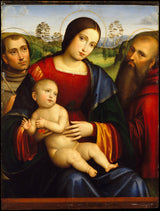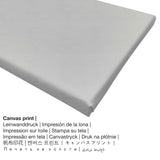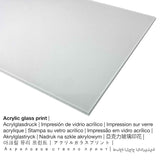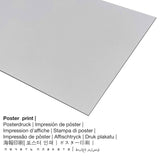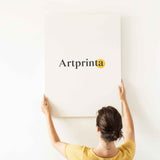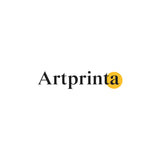Francesco Francia, 1512 - Madonna na Nwatakịrị ya na Ndị Nsọ Francis na Jerome - mbipụta nka mara mma
Ụtụ gụnyere. Mbupu gbakọrọ na ndenye ọpụpụ.
Ihe omuma ihe omuma
a nka ochie artwork na aha Madonna and Child with Saints Francis and Jerome was made by the painter Francesco Francia in 1512. The original was made with the size: 29 1/2 × 22 1/2 in (74,9 × 57,2 cm) Framed: 39 3/8 × 32 5/8 in (100 × 82,9 cm) and was manufactured with the Usoro of mmanụ na ọla edo n'elu osisi. Kedu ihe ọzọ, a na-etinye ihe osise ahụ na Ụlọ ihe ngosi nka nke Metropolitan mkpokọta, nke dị na New York City, New York, Njikota Obodo Amerika. Ọrụ nka a, nke bụ akụkụ nke ngalaba ọha a na-enye ya site n'ikike nke Ụlọ ihe ngosi nka nke Metropolitan, New York, mkpokọta Robert Lehman, 1975. The creditline of the artpiece is the following: Robert Lehman Collection, 1975. Moreover, alignment is in Eserese format ya na oke akụkụ nke 3: 4, nke pụtara na ogologo bụ 25% mkpụmkpụ karịa obosara. The painter, goldsmith Francesco Francia was a European artist from Italy, whose art style was primarily High Renaissance. The High Renaissance artist lived for 70 afọ, born in 1447 in Bologna, Bologna province, Emilia-Romagna, Italy and died in the year 1517.
Nhọrọ akụrụngwa ngwaahịa gị
Ndepụta ndetu ngwaahịa na-enye gị ohere ịhọrọ ngwa na nha nke nhọrọ gị. Anyị na-ahapụ gị ka ịhọrọ nha na akụrụngwa ọkacha mmasị gị n'etiti nhọrọ nhazi ngwaahịa ndị a:
- Mbipụta kanvas: The canvas print is a printed cotton canvas mounted on a wooden stretcher. A canvas produces a unique effect of three-dimensionality. A printed canvas of this work of art will provide you with the unique opportunity of transforming your into a large artpiece like you know from galleries. Canvas prints are relatively low in weight, meaning that it is easy to hang up the Canvas print without additional wall-mounts. Canvas prints are suited for all kinds of walls.
- Aluminom dibond mbipụta (ọla): This is a metal print made on aluminium dibond with a true effect of depth. The Aluminium Dibond Print is your best introduction to fine art replicas on aluminum. For our Direct Print On Aluminum Dibond, we print the selected artwork onto the aluminium composite surface. Colors are luminous in the highest definition, fine details of the print appear very clear, and you can notice the matte appearance of the print.
- Mbipụta iko acrylic (nke nwere ezigbo mkpuchi iko): The print on acrylic glass, often denoted as a an art print on plexiglass, will turn the original artwork into wonderful décor and makes a great alternative to aluminium or canvas fine art replicas. Your work of art is made with modern UV direct printing technology. Our real glass coating protects your selected art print against light and external influences for decades.
- Akwụkwọ mmado ebipụtara (ihe kwaaji): A poster is a printed canvas with a slight surface texture, which resembles the actual masterpiece. Please keep in mind, that depending on the absolute size of the poster print we add a white margin of approximately 2-6cm around the print in order to facilitate the framing with a custom frame.
Nkwupụta iwu: We try the best we can to describe the art products with as many details as possible and to display them visually in our shop. Although, the pigments of the printing material, as well as the imprint can vary somehwat from the representation on your screen. Depending on the settings of your screen and the quality of the surface, not all colors are printed as exactly as the digital version. Bearing in mind that the art prints are printed and processed by hand, there may also be slight discrepancies in the motif's size and exact position.
Banyere ngwaahịa
| Nkewa edemede: | nka nka |
| Usoro mmeputakwa: | dijitalụ mmeputakwa |
| Usoro mmepụta: | Mbipụta UV ozugbo (mbipụta dijitalụ) |
| Mmalite nke ngwaahịa a: | German mere |
| Stockdị ngwaahịa: | na mmepụta ihe |
| Eji ngwaahịa a chọrọ: | nka mgbidi, ihe ndozi ụlọ |
| Ndozi onyonyo a: | nhazi ihe osise |
| Ụdị anya: | 3: 4 - ogologo: obosara |
| Nsonaazụ: | ogologo bụ 25% mkpụmkpụ karịa obosara |
| Akụrụngwa ị nwere ike ịhọrọ site na: | akwụkwọ mmado (akwụkwọ kwaaji), mbipụta enyo acrylic (nwere ezigbo mkpuchi iko), mbipụta akwa akwa, mbipụta ọla (aluminium dibbond) |
| Nhọrọ nha nke akwa akwa n'elu etiti ihe na-agbatị (mbipụta kwaaji): | 30x40cm - 12x16", 60x80cm - 24x31", 90x120cm - 35x47", 120x160cm - 47x63" |
| Acrylic glass print (nwere ezigbo mkpuchi iko) nhọrọ: | 30x40cm - 12x16", 60x80cm - 24x31", 90x120cm - 35x47", 120x160cm - 47x63" |
| Nhọrọ nha nke akwụkwọ mmado (akwụkwọ kwaaji): | 30x40cm - 12x16", 60x80cm - 24x31", 90x120cm - 35x47" |
| Mbipụta aluminom (ihe alumini debond ihe): | 30x40cm - 12x16", 60x80cm - 24x31", 90x120cm - 35x47" |
| Igwe onyonyo: | agunyeghi |
Ozi ndabere gbasara ọrụ nka mbụ
| Aha nka nka: | "Madonna and Child with Saints Francis and Jerome" |
| Nchịkọta nke ọrụ nka: | sere |
| Category: | nka ochie |
| oge: | 16th narị afọ |
| Afọ nka: | 1512 |
| Afọ nka: | 500 afọ |
| Ọkara nke ihe osise izizi: | mmanụ na ọla edo n'elu osisi |
| Nha nke ihe osise izizi: | 29 1/2 × 22 1/2 na (74,9 × 57,2 cm) Ekepụtara: 39 3/8 × 32 5/8 na (100 × 82,9 cm) |
| Ụlọ ihe ngosi nka / mkpokọta: | Museumlọ ihe ngosi nka nke Obodo |
| Ebe ngosi nka: | New York City, New York, Njikota Obodo Amerika |
| Webụsaịtị ihe ngosi nka: | www.metmuseum.org |
| Ụdị nka nka: | ngalaba ọha |
| Site n'aka: | Ụlọ ihe ngosi nka nke Metropolitan, New York, mkpokọta Robert Lehman, 1975 |
| kreditline ọrụ nka: | Nchịkọta Robert Lehman, 1975 |
Tebụl ozi omenkà
| Ihe nkiri: | Francesco France |
| Aha ndị ọzọ: | Francesco di Marco gen. il Francia, Rombalini Francesco de', Francia Il, Fran.co Franza, Frantia, Frangia Vecchio, Francia vecchio bolognese, frangi, Raibolini Francesco di Marco, Francia Raibolini Francesco, Francesco Raibolini, Raibolini Francesco de', francesco raibolini gen. francia, Francesco Francia bolognese, Fran., Francesco Francia, Raibolini Francesco di Marco di Giacomo, Rombolini Francesco de', Francesco di Marco gen. Il Francia, Francia Francesco di Marco di Giacomo il Raibolini, Frangia Francesco, Francia Bolognese Francesco, De' Raibolini Francesco, Francia vecchio, Francisco Francia, Franc. Francia, De' Rombulini Francesco, Frangi Francesco, Franza Francesco, Francia bolognese, De' Rombolini Francesco, Frangia, François Francia, Francesco Francia or Raibolini, Franza, Fra. Francia, Francia Vecchio Francesco, Francia Francesco (Francesco Raibolini), Rombulini Francesco de', francesco raibolini gen. il francia, Il Francia, F. Francia, Raibolini Francesco, Francia, Fran.ci, Francia Francesco, Francesco da Bologna, Francia François, F. France, De' Rombalini Francesco, Fr. Francia |
| okike onye nka: | nwoke |
| Obodo onye nka: | Italian |
| Ọrụ nke onye na-ese ihe: | onye na-ese ihe, onye na-eji ọla edo |
| Obodo obibi: | Italy |
| Nhazi nke onye nka: | nna ukwu ochie |
| styles: | Akwa Renaissance |
| Ndụ: | 70 afọ |
| Afọ ọmụmụ: | 1447 |
| Ebe amụrụ onye: | Bologna, Bologna n'ógbè, Emilia-Romagna, Italy |
| Afọ ọnwụ: | 1517 |
| Nwụrụ na (ebe): | Bologna, Bologna n'ógbè, Emilia-Romagna, Italy |
© Nwebiisinka nke | www.artprinta.com (Artprinta)
Artwork information from The Metropolitan Museum of Art (© - by The Metropolitan Museum of Art - Museumlọ ihe ngosi nka nke Obodo)
Acquired by Robert Lehman in 1944, this painting of the Madonna and Child by the Bolognese artist Francesco Francia is an example of the devotional paintings for which he was well-known. The Virgin, clothed in expansive swathes of colored drapery, supports the Christ Child on her lap. The Child holds a pair of cherries, a reference to the sacrificial blood of Christ. To the Virgin’s right is Saint Francis wearing the traditional tonsure and heavy monastic robes. The bearded figure on the other side is likely Saint Jerome. In the background are trees and hills, which place the holy figures in an earthly setting and make them more accessible and approachable to the viewer. Francia trained and worked successfully as a goldsmith before turning to painting, identifying himself as such in his signature on the parapet (FRANCIA AURIFABER P.). His style is marked by a general sweetness and a smooth quality, which reveals the influence of the famous Umbrian painter Perugino. In his 1568 edition of the Artist’s Lives, the sixteenth-century biographer and painter Giorgio Vasari described Francia’s "sweet harmony of coloring" that prompted people to run "like madmen to this new and more lifelike beauty." Vasari saw Francia as an artist at the verge of a new and exciting age of painting, which would be realized fully by Leonardo da Vinci, Raphael, and Michelangelo.Francia painted many images of analogous composition. A painting in the Pinacoteca Vaticana is so similar to the Lehman panel that the two were likely made from the same cartoon, a full-scale drawing that was used to transfer the design to the panel. The existence of several iterations of this Madonna and Child composition points to the popularity of these images, which were likely used for personal devotion and contemplation in private homes and chapels.

